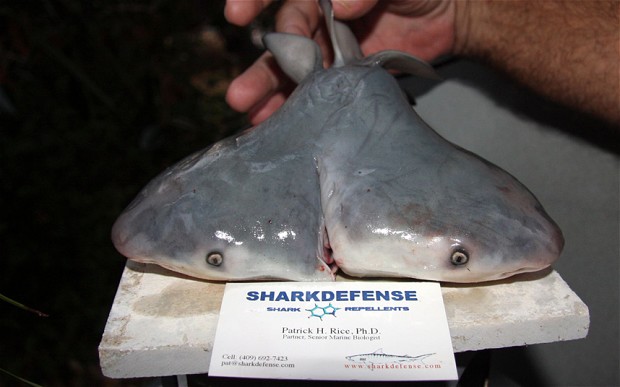The final Friday of March is here and with March Madness fully underway, we found some crazy articles to give you your weekly dose of the wacky, weird and wonderful. Sometimes nature can write better movie plots than what Hollywood can come up with, and this case of a two-headed shark is right up there for a new movie on the SyFy network. A fisherman recently caught a bull shark near the Florida Keys, discovering the one of the shark’s live fetuses had two heads. The fisherman kept the odd specimen, and shared it with scientists, who described it in a study published online today (March 25) in the Journal of Fish Biology.
[via Huffington Post]
The ginormous garbage gyres in the oceans are quite disturbing, but one resourceful student has come up with a way to rid us of these flotillas of plastic. One resourceful, 19-year-old aerospace engineering student has come up with a plan to tackle the problem. Boyan Slat designed this Ocean Cleanup Array that uses long booms that float on the surface that funnel trash into a processing platform. The hopeful plan is currently studying the feasibility of this array that could clean up a gyre in just five years, while removing 7,250,000 tons of plastic waste from the oceans. Check out his TED presentation of the project below:
[via Treehugger]
One Chinese fishmonger had a surprising discovery after preparring a squid, finding a live three-pound explosive device inside the creature. Although the bomb was rusty and old, it was operational meaning it could have exploded at any time. Authorities believe the bomb may have been dropped by a fighter jet passing nearby. The squid was caught off the Guangdong province and taken to a local fish market. The bomb squad did come in to take the bomb away and dispose of it in an controlled explosion.
[via NY Daily News]
[vimeo width=”600″ height=”337″]http://vimeo.com/62880818[/vimeo]
Meet Cyro, a robotic jellyfish that could be the future of underwater surveillance for the US Navy developed by a team of engineers from Virginia Tech. At 5 1/2 ft. wide and weighing 170 pounds, the robot features eight mechanical legs ringing a metal chassis, that mimics the unique, efficient underwater propulsion of a jellyfish. To finish off the design, Cyro is covered in silicone to replicate the jellyfish’s wavy, bioluminescent mesoglea. The robot was developed thanks to a five-year grant from the Office of Naval Research.
[via WIRED]
For those of you interested in the psychedelic properties of various organisms, here is an interesting tale. There is possible evidence of the first psychedelic drug of marine origin — 5-Bromo-DMT and 5,6-dibromo-DMT that are found in the sponges Smenospongia aurea and S. echina. Before you head off to a tropical sea with Pink Floyd, the Grateful Dead and Phish loaded up on your iPod, make sure you check this lengthy article out discussing the truthiness behind the story.
[via VICE]






